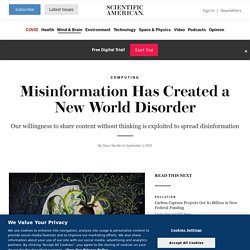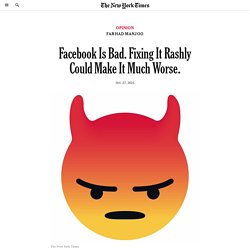

Misinformation Overload – John Hubbard. Overview:We live in uncertain times.

With big data and a boom in our ability to transmit ideas comes a seemingly greater amount of erroneous information, and therefore the need for everyone to be able to properly identify, discredit, and prevent the spread of falsehoods. What follows is a tour of how much the misrepresentation of reality pervades our world (from whimsical pranks and well-intentioned hoaxes to full-blown propaganda intended to defraud and manipulate), concluding with a discussion of tactics for taking a rational and scientific view so that we may both decrease our susceptibility and improve our ability to detect misinformation. “Oceania had always been at war with Eastasia.” — George Orwell, 1984 “We had no domestic attacks under Bush.” — Rudolph Giuliani, 2010 In 1985, Sports Illustrated ran a story about Sidd Finch, a Mets prospect who had a 168 mile-per-hour fastball.
There are numerous examples of satirical news pieces being mistaken for actual reporting. Misinformation Has Created a New World Disorder. As someone who studies the impact of misinformation on society, I often wish the young entrepreneurs of Silicon Valley who enabled communication at speed had been forced to run a 9/11 scenario with their technologies before they deployed them commercially.

One of the most iconic images from that day shows a large clustering of New Yorkers staring upward. The power of the photograph is that we know the horror they're witnessing. It is easy to imagine that, today, almost everyone in that scene would be holding a smartphone. Some would be filming their observations and posting them to Twitter and Facebook. Powered by social media, rumors and misinformation would be rampant. Writing's power to deceive. When I was researching and writing my new book, “The Gist of Reading,” I wanted to explore long-held assumptions about reading and how we process what we read.

Some of these assumptions have changed through time. For example, as novels became popular in the 18th century, many warned that they were dangerous and had the potential to cultivate ignorance and immorality in readers, especially female ones. Today, many would consider that view antiquated. Common Mythconceptions – World’s Most Contagious Falsehoods — Information is Beautiful.
La disinformazione è una bestia dai mille volti: impariamo a riconoscerla. Mathématiques – Comment tromper avec des graphiques. Un graphique a généralement pour but d’illustrer un propos souvent trop complexe pour le lecteur ou le téléspectateur, et qui gagnerait en clarté en étant présenté de manière synthétique.

Cette version « visuelle » est donc régulièrement choisie pour exposer des données de façon immédiate et avec le moins d’ambiguïté, que ce soit pour faire comprendre rapidement l’évolution du chômage, les résultats extraordinaires d’un dentifrice sur l’acidité de notre bouche ou la diminution de la dette du Lesotho. Mais cette présentation ne va pas toujours de soi : les choix des axes, des origines, de la présentation, des données illustrées peuvent tout aussi bien tromper qu’éclairer et faire passer une augmentation significative pour stagnation évidente, une homogénéité de fait pour disparité flagrante, etc.
Désinformation. Disinformation. Désinformation. Disinformation. Techniques_desinformation.pdf (Objet application/pdf) La civilisation du poisson rouge. Petit traité sur le marché de l’attention. Tous les médias sont fondés sur l’économie de l’attention, mais la connexion permanente qu’autorise internet et nos smartphones, fait que l’on tente d’attirer notre attention toute la journée.

Vous aimez cet article ? Partagez le ! Par Farid Gueham.Un article de Trop Libre. Political correctness: how the right invented a phantom enemy. Three weeks ago, around a quarter of the American population elected a demagogue with no prior experience in public service to the presidency.

In the eyes of many of his supporters, this lack of preparation was not a liability, but a strength. Donald Trump had run as a candidate whose primary qualification was that he was not “a politician”. Depicting yourself as a “maverick” or an “outsider” crusading against a corrupt Washington establishment is the oldest trick in American politics – but Trump took things further. He broke countless unspoken rules regarding what public figures can or cannot do and say. Every demagogue needs an enemy. Trump claimed that Barack Obama and Hillary Clinton were willing to let ordinary Americans suffer because their first priority was political correctness. Throughout an erratic campaign, Trump consistently blasted political correctness, blaming it for an extraordinary range of ills and using the phrase to deflect any and every criticism.
«Cancel culture» mode d'emploi. Facebook Is Bad. Fixing It Rashly Could Make It Much Worse. The nicest thing you can say about the Health Misinformation Act, proposed in July by the Democratic senators Amy Klobuchar and Ben Ray Luján, is that it means well.

The internet has been a key accelerant of widespread myths, misunderstandings and lies related to Covid-19; Klobuchar and Luján’s bill would force online companies like Facebook to crack down on false information during public health emergencies, or lose immunity from lawsuits if they don’t. There’s only one problem: What is health misinformation? I know of no oracular source of truth about Covid-19. Scientific consensus has shifted dramatically during the pandemic, and even now experts are divided over important issues, such as whether everyone should get a vaccine booster shot.
Klobuchar and Luján’s bill elides these complications.